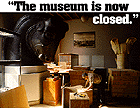 Continued
Continued The University of Chicago Magazine June 1996
The University of Chicago Magazine June 1996 Continued
Continued
though her discussion topic is intense: why the institute's hoard of ancient relics, representing the scope of Near Eastern civilizations now stands in peril.
She asks her listener to imagine an object-say, a clay jar-buried millennia ago. In its early subterranean years, the jar "starts to change its physical characteristics," often developing tiny cracks, D'Alessandro explains. With more time, the jar will "reach equilibrium with its new environment," slowing the decay-more so if the burial soil is clay, which provides a nearly airtight tomb. Still, moisture often seeps into this grave, bearing soluble salts that soak into the cracks already formed.
Enter the intrepid archaeologist who liberates the jar. Like an agoraphobe dropped into the middle of a shopping mall, the object finds itself assaulted with a crowd of environmental changes-shifts in light, oxygen, temperature, and humidity-that renew the progress of decay.
For artifacts stored in the Oriental Institute, this process is exacerbated by Chicago's pendulous weather extremes: especially humidity, which can range from 5 to 99 percent between winter and summer. "When the radiators come on in the winter," says D'Alessandro, all the moisture stored within an object's cracks "gets drawn to the outside, and with it it's bringing the salts. And it gets to the point where the salts actually become solids again, because the moisture is taken out. So you have these crystals forming, strong enough to push apart the structure of the ceramic or stone-whatever they're in." In summer, these salts "go back into solution and seep back inside," until winter's dryness calls them forth again.
Over time, the effects of this cycle can injure unearthed objects with a sledgehammer's force. Harm to the institute's collection has so far been only minor, says D'Alessandro. "Clay tablets have suffered the worst damage. It's a very small percentage, but as many as 15 have become pulverized." Metals and organic material-ivory, leather, textiles, and mummified remains-are also most immediately endangered, but even the fate of King Sargon's colossal carved reliefs now depends upon the vagaries of Chicago's humidity index.
William Sumner recalls Hanna Gray's exact words as she looked across her desk at him one day in 1989: "It's time to do something about the Oriental Institute Museum."
While not exactly Churchillian, the remark was momentous to Sumner, who was discussing the job of Oriental Institute director with Gray-a job he'd take that same year. The University was preparing to launch a major capital campaign in conjunction with its centennial and Gray, then Chicago's president, was letting Sumner know it was already decided that the institute's needs would be part of those fund-raising efforts.
Seven years later, the Institute's Legacy Campaign--
Continue reading, "The Museum is now closed."
Go to:
Return to June 1996 Table of Contents